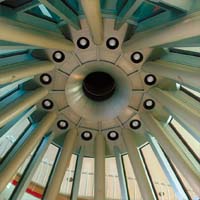










|

|

|

|

|

|

|

|

|

|
|

|
||||

|
|||||
|
|
||||

Douglas Cardinal is a dominant figure in the world of architecture. In conversation with him, he states: "Buildings should make a statement, declaring the commitment of the people for whom it was built. We regard the design process as a partnership between the architect and the patrons."
"The method by which my buildings come into being is an organic process where the shape and form of each room is 'wrapped' around its function. Thus the building begins with the particular, with its individual functions, but develops into a complete organism. "Once the shape of a room is determined by its function, the room may be understood to act much like a single cell, with its own genetic code. Through the use of diagrams, area relationships are planned between the individual 'cells', to create a matrix of rooms. With this matrix, the building begins to design itself. Through a natural and organic process, a spinal cord develops as the rooms, or cells, form into clusters of relationships. In this initial stage the design is quite flexible as the cells in the cord may be rearranged in endless variations. "Once the relationships between the functions evolve, the building is transported onto the site. There you just un-conceal it. The natural elements, such as wind and sun angles, will shape the building from the outside in. A balance must be achieved between the external and internal elements that shape the building, much like a tree which has its own genetic code, but which is also shaped by the natural forces acting upon it. "A building houses people. With this in mind, I take into account the needs of the people, so that the building complements their activities. "When the form of the entire organism is defined, images that give an aesthetic expression to the character of the building are incorporated into the design. The exterior shell of the building is a sculptural expression of the themes and ideas of the design, and of its internal environment. In this way, the organic process, the internal and external, binds together to create a work of architecture." - In conversation with Douglas Cardinal conducted by Denise Kupferschmid, Queen's University |
|||||
|
|
home | bio | showcase | design | interpretations | projects | awards | biblio |
|
|
|
||